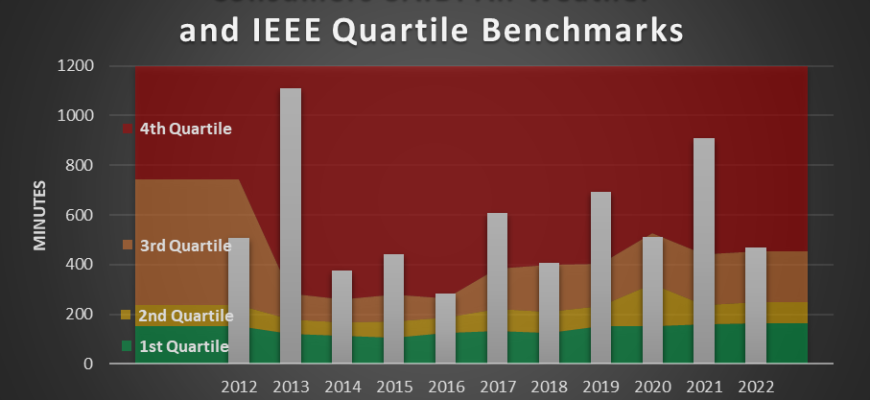- August 22, 2024
- by Spencer Almen
Michigan is experiencing a period of unreliable electricity service, but onsite solar installations can help protect large electricity consumers from the risks of increased pricing and service disruptions.
Aging and inadequate infrastructure, maintenance backlogs, increasingly severe weather, geographic constraints, and rising electricity demand all contribute to the need for major investments if the grid is to be reliable in the future.
In this post, we discuss reliability challenges on the Michigan electrical grid, especially in reference to Consumers Energy, and then explore how onsite solar can help address these challenges.
Tight Generation Capacity Supply-Demand Balance Shown in Wholesale Market Auctions
One indication of the scarcity of electricity generation needed to meet demand in Michigan is the annual generation capacity auction conducted by the Midcontinent Independent System Operator (MISO). MISO is the organization that oversees the regional electricity grid for Consumers Energy and most of Michigan.
MISO’s capacity auction allows generation resources to be shared across the market’s footprint, but only to the extent that there is transmission capacity to deliver capacity imports to each of ten different Local Resource Zones (LRZs). MISO’s LRZ 7 comprises most of Michigan’s Lower Peninsula, and it has settled at the maximum price allowed – the “Cost of New Entry,” or CONE – in two of the last five auctions.
This result is meant to signal to the market that more generation capacity is needed to reliably serve electricity demand in that LRZ. High capacity prices are also passed on to the customers of electric utilities that buy that capacity. As shown in the image below, LRZ 7 (along with the other LRZ’s in MISO’s Midwest region) settled at the maximum price of $236.66/MW-Day in the 2022 auction.
While new transmission lines could be built to increase the capacity that can be imported into Michigan, the Great Lakes pose a major hurdle to building new connections to many neighboring systems. And even if the transmission grid allows sufficient electricity imports to avoid shortfalls, limited import capacity means that utilities must run more expensive peaking generators instead of importing electricity from cheaper generation in other areas.
Resilience and Reliability Issues on the Local Distribution Grid
Michigan has suffered from some of the least reliable electricity service in the country. Years of poor service resulted in the establishment of the MI Power Grid initiative in 2019. One of the outcomes of the initiative was the establishment of a Distribution System Reliability Metrics webpage. One key metric reported on this website is the System Average Interruption Duration Index (SAIDI), which represents the total number of minutes of interruption the average customer experiences in a given year.
As the chart below illustrates, Consumers’ SAIDI has consistently been in or near the 4th quartile, indicating that Consumers’ customers have experienced outages for more time than the customers of 75% or higher of utilities.
Reliability Challenges Are Leading to Rate Increases
Consumers Energy filed its latest application to increase electricity rates on May 31, 2024. In its application, it stated that “the reliability and resiliency of the electric distribution system is challenged by increasingly severe weather and ongoing deterioration of the System.” That application requested authority from the Michigan Public Service Commission to raise rates enough to generate an additional $303MM to cover the costs of its “Reliability Roadmap,” which seeks to improve the system’s reliability to the point that Consumers will rise into the 2nd quartile for reliability among national utilities.
The large price tag for the Roadmap shows two things: (1) there is a lot of work to be done to strengthen Consumers’ system, and (2) that there will be ongoing upward pressure on utility rates to pay for those improvements.
The Reliability Roadmap also describes broader changes to the way electricity is utilized by Consumers’ customers. Consumers modeled future scenarios with different levels of customer adoption of distributed solar generation and increased electricity demand from electric vehicles and electric space heating demand as heat pumps replace gas heating systems. As shown in the image below, their modeling of an “Accelerated Transition” scenario showed that 9% of their distribution system circuits could be at risk of being overloaded by 2030.
Onsite Solar Is the Best Remedy for Grid Constraints
Many businesses that rely on large amounts of reliable and affordable electricity to function are probably asking themselves the same question: What is the best way to protect our business against all of the risks faced by the Michigan electricity system in the coming years?
The obvious answer is onsite solar, which reduces the amount of electricity that must be delivered to a facility, and mitigates the risk of ongoing rate increases as Michigan utilities work to improve their reliability.
Onsite solar delivers electricity directly to a facility, without relying on either the aging local distribution grid or the constrained regional transmission grid. Onsite solar often generates at full or nearly full capacity during hot summer days when the grid is most stressed, and so it is an excellent way to reduce the risk of the distribution circuit a facility depends on being overloaded and the utility being required to cut power to avoid system damage or collapse.
Learn More
Does it seem like onsite solar might be a good solution to meet your economic and energy goals? Fill out the form below to get started.
Nokomis Energy is a clean energy developer focused on the Upper Midwest and Mountain West regions. Our mission is to identify opportunities to create clean, low-cost energy projects for our customers. We work directly with our customers and partners to implement and build clean energy solutions that work for your specific needs.




